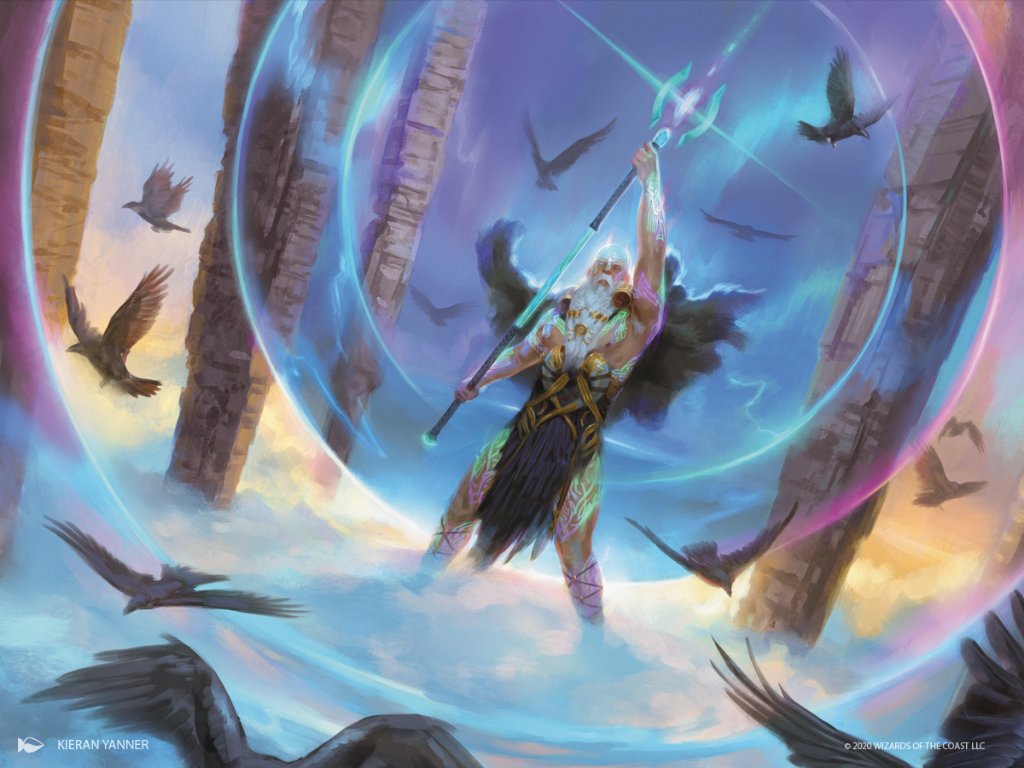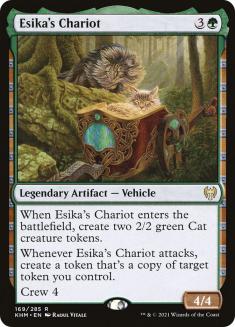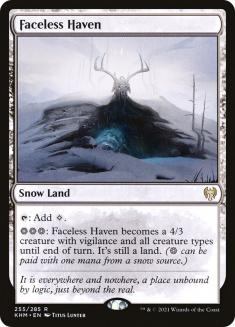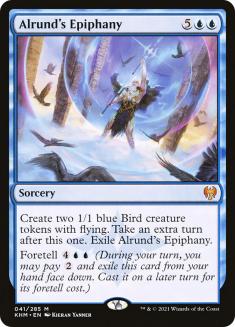I thought we were through with this. Throne of Eldraine rotated, taking most of the dominant cards from Standard over the last two years. This was going to be a new era where we returned to the good old days of balanced, dynamic Standard metagames. A rebirth if you will.
And then this happened:
Those are the final standings from the latest SCG Tour Online Championship Qualifier, and if you look further down the page, it doesn’t get any prettier. It’s only two weeks into Innistrad: Midnight Hunt season and our collective dreams have turned into a nightmare.
I try very hard to not jump too quickly onto the ban bandwagon. I like to give the community at least some time to get creative and find ways to break out of these stagnant metagames. But recent history does not project that as a likely outcome, so we have to be prepared to act quickly should no metagame panacea materialize.
Now, the interesting question is what that action should be. Looking at the results above, it seems like the problem deck is Mono-Green Aggro❄. With how popular and successful Esika’s Chariot has been over the last two weeks, that would be an easy place to land. Past that, the emergence of Mono-White Aggro❄, also sporting a snow theme in order to leverage Faceless Haven, makes the powerful creature-land a potential target.
After all, for as much hype as Pack Rat and Thassa, God of the Sea got during the devotion era with Theros, it was Mutavault that put the monocolored decks above the pack. Creature-lands at a good rate are incredibly valuable, especially for aggressive decks that need to keep the pressure coming through all manner of removal and other forms of disruption. When you limit yourself to one color as an aggro deck, you already make a significant gain in consistency, but further incentivizing the choice with such a powerful card can easily imbalance a metagame.
Despite the compelling reasons to target Esika’s Chariot and Faceless Haven, I don’t think either is the real problem card that’s driving us towards such a narrow, stagnant metagame. It’s actually the key card from one of the least successful decks in the tournament, Alrund’s Epiphany.
Izzet Epiphany was easily the most hyped deck last week, and I’m sure many of us were expecting it to produce a dominant weekend. Instead it barely cracked the elimination rounds while putting up a losing record as one of the most played decks in the tournament. The easy explanation is that we’re seeing the metagame evolve to answer the new top deck, and we’ll continue to see that in the coming weeks, with players now targeting the monocolored aggro decks.
If that indeed happens, I’ll be quite happy. But that’s not what I’m expecting. Despite the poor showing, I think Izzet Epiphany can adapt to regain its crown, or at least maintain a major presence in the metagame. As a result, it will be difficult for the metagame to continue to evolve, because Izzet Epiphany will always be there to punish the interactive midrange decks that tend to prey on aggro strategies.
I would submit that the results of last weekend are largely driven by Izzet Epiphany’s impact on the metagame, and unfortunately the deck was a victim of its own success, pushing tons of players to its natural predators. So while Mono-Green Aggro❄ has the best numbers, it’s not indicative of the deck’s natural strength, but of a narrow metagame in which it was incredibly well positioned.
As a result, banning cards from these aggro decks is akin to treating the symptom, not the disease. Removing Alrund’s Epiphany from the metagame will allow for much more diversity in how we combat powerful aggressive strategies, since it will allow midrange decks to flourish.
The Combo-Control Squeeze
I’m not the first person to bring up banning Alrund’s Epiphany.
But I do think much of the discussion around the card has been misguided. It’s largely been predicated on the repetitive sequences that Time Walk effects create or how the advent of powerful planeswalkers and other sources of cascading card advantage make Time Walk effects too strong. I don’t think the details of Alrund’s Epiphany are the problem, and it certainly isn’t any issue with using extra turns to generate cascading card advantage, since Izzet Epiphany doesn’t play any such cards.
The problem here is fundamental to the strategy that Izzet Epiphany employs: combo-control. By this I mean a deck that plays reactively in the early and mid-game, as a control deck would, but rather than winning the game with a big creature or a planeswalker over the course of several turns, it works towards setting up a combo-finish, in this case Galvanic Iteration and Alrund’s Epiphany to take two extra turns in a row.
Simply put, a properly executed combo-control strategy is the most powerful strategy you can employ in Magic. This is because there’s virtually no appropriate counter to it. Against control decks you need to measure your threats so you have a solid, consistent stream of pressure that never lets up so they don’t have a free turn to land their key planeswalker or reload with a card draw spell. Against combo decks you need to take more risks in order to close the game out quickly, before they can overcome whatever disruption you can present.
These two gameplans contradict each other, so no matter what you do, there’s a way for the combo-control player to beat you. If you slow down too much, they will combo you before you can end the game. If you play too quickly, you’ll run into their sweepers. And if you make a mistake at any point while navigating this tightrope, the combo finish means you don’t have any time to recover. The game is essentially over, if not literally over. This is the fundamental tension that makes combo-control decks so difficult to beat, and it’s not going away.
Simply put, a properly executed combo-control strategy is the most powerful strategy you can employ in Magic
It should also then be of no surprise that the most successful decks against Izzet Epiphany have been the aggro deck that’s most resilient to removal and sweepers (Mono-Green) and the aggro deck that has the most disruption for the combo (Mono-White). It doesn’t get better than these two decks, and they have a limited number of tricks to throw at the Izzet deck. If Epiphany players are able to figure those out, it’s game over.
The Secret to Unlocking Combo-Control
Once you accept that a sufficiently powerful combo-control strategy is fundamentally broken, the worry becomes whether Alrund’s Epiphany will be replaced by some other over-the-top card. What makes it the keystone card in this particular iteration of the strategy?
The critical feature that separates broken combo-control decks from mediocre ones is how functional the finishers are as standalone cards in the control deck. How much can they help you interact with your opponent and buy time should you need them to. Alrund’s Epiphany and Galvanic Iteration are excellent in this role, since the latter can be used in combination with another removal spell for a nice double-spell turn in the mid-game, and the former creates a free battlefield presence at virtually no material cost, since you recoup the card and mana used to cast it on your extra turn.
Those Bird tokens can start pressuring a Wrenn and Seven or chump block to protect your life total just long enough to stabilize. It’s not much, but those tokens are critical for the card because they let you catch up from behind where a card like Time Warp would not, not to mention their functionality when executing the combo.
Without this functionality, you’d introduce a lot of inconsistency to the deck where you draw too many combo pieces and aren’t able to play a control role well-enough to win games. And the more you trim away from the combo in order to make the control role work, the worse you make the combo part of the deck. It’s the overlapping functionality of the combo pieces that makes you a good control deck with a combo finish rather than a mediocre control deck with a combo finish. Incidentally, this is why you never saw Harmless Offering find success in Standard — it forced you to play too many individually weak cards to make the combo work.
So you absolutely need to ban one of the combo pieces, and since Alrund’s Epiphany is the most overtly powerful one, it’s the one I’d side with.
The Importance of Midrange
My final issue with Izzet Epiphany and combo-control in general is the fact that it pushes out traditional midrange strategies. Midrange decks are what most people gravitate towards because they’re so balanced with threats and answers. You feel like you can play any kind of game you need to be successful, and have a ton of freedom to adjust your deck to a changing metagame.
That versatility is important to creating a dynamic metagame, because sets are printed with such a wide array of threats and answers that are playable in the right circumstances. But combo-control decks punish midrange decks for playing too many answers, thereby pushing them to become aggro decks in order to compete. We saw this last weekend when all the players who played Gruul or three-color Esika’s Chariot decks coalesced around Mono-Green Aggro❄. And because the combo-control deck has the flexibility to adapt, it’s rare to see the midrange decks return.
Contrast that to another strategy that traditionally kills midrange decks: ramp. Ramp is effectively a combo strategy: it’s linear, proactive, and looks to overpower its opponents. But by virtue of its linearity, it doesn’t have much versatility. So when the aggro decks show up to punish a ramp-heavy metagame, the ramp decks recede, once again allowing the midrange decks to return. That doesn’t happen when your overpowering strategy also has plenty of interaction.
I’m no fan of midrange decks myself, but all the best Standard environments were led by strong midrange strategies, whether it was Jund with Farseek and Thragtusk during Return to Ravnica or Siege Rhino and friends during Khans of Tarkir. Those two creatures took a lot of flak during their time in the sun, with calls for bans, but we now look back fondly on those eras for how balanced, diverse, and dynamic those metagames were. And it’s because midrange decks offer you the most avenues for interaction. On three consecutive weekends, you can find success against a midrange strategy by going under them with aggro, going over the top of them with ramp or control, and playing them straight up with an opposing midrange deck.
How you play against midrange decks depends largely on how they’re being built at that moment. And once you exploit that weakness they will find a way to fix it, but in doing so open up a different weakness that you can exploit. The fundamental nature of midrange decks leads to a diverse, dynamic metagame that changes week to week. By pushing these decks out, we naturally create metagames which devolve into a solved state.
I’m confident that once they’re freed from the clutches of Alrund’s Epiphany, that midrange decks can keep mono-colored aggro decks in check. But if you get rid of Esika’s Chariot or Faceless Haven because those decks had better numbers last weekend, you’re just opening the door for Izzet Epiphany to be completely dominant.
Alrund’s Epiphany doesn’t necessarily have to be banned right now, but if things don’t change in the next week or two, then WotC should act quickly because players will not hesitate to give up on Standard entirely after what they’ve endured over the last two years. It’s better to rip the band-aid off early.





